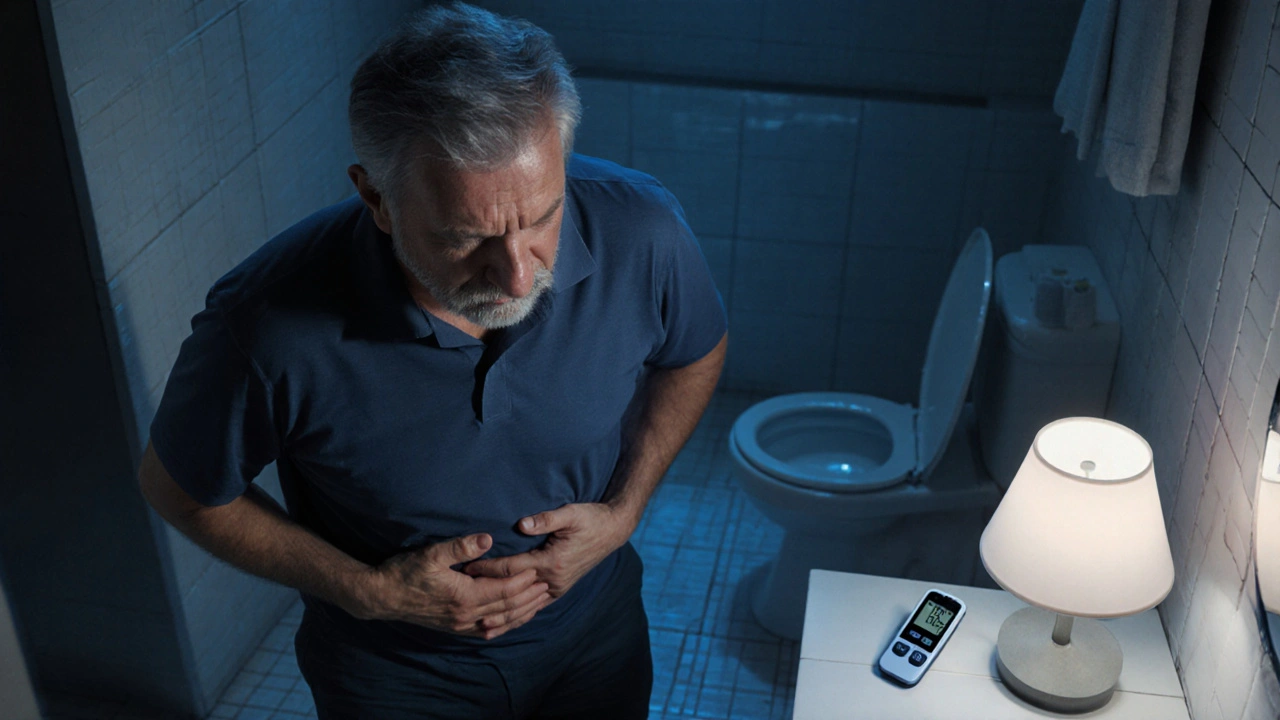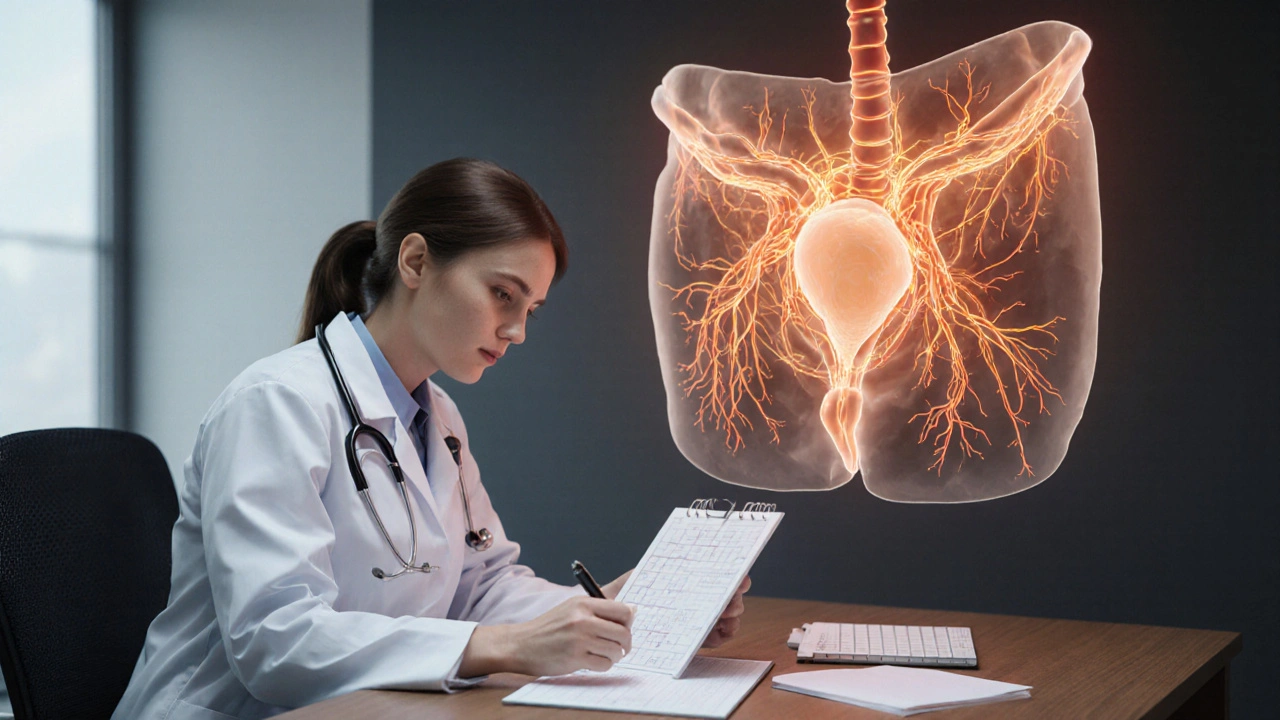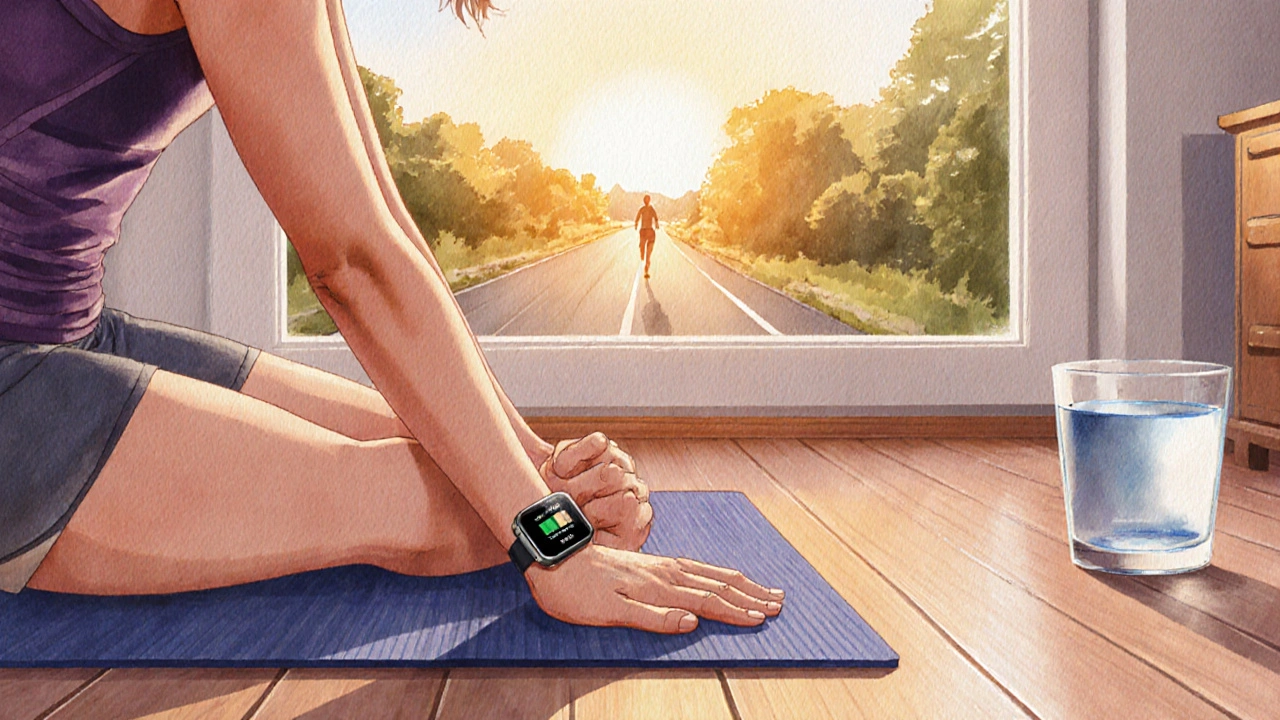
Diabetes & Bladder Symptom Tracker
Track Your Symptoms
Monitor your urinary symptoms and blood sugar levels to identify patterns and better manage overactive bladder.
Enter Your Data
Your Symptom Patterns
Enter your symptoms to see personalized recommendations.
Symptom History
| Date/Time | Blood Sugar | Frequency | Urgency |
|---|
When people talk about diabetes, the spotlight usually falls on blood sugar, heart disease, or foot problems. What’s often missed is how high glucose can mess with the bladder’s ability to hold and release urine. This article unpacks the link between overactive bladder and diabetes, walks through the symptoms you might notice, and offers practical steps to keep both conditions under control.
What Exactly Is Overactive Bladder?
Overactive bladder is a syndrome characterized by a sudden, uncontrollable urge to urinate, often accompanied by frequent trips to the toilet and, in many cases, leakage (urge incontinence). The condition is defined medically as having at least one episode of urgency per day and typically more than eight voids in a 24‑hour period. It’s not a disease itself but a set of symptoms that signal underlying bladder dysfunction.
Key signs include:
- Urgent need to pee that’s hard to postpone
- Nocturia - waking up one or more times at night to void
- Frequent daytime urination (more than 8‑10 times)
- Occasional leakage after the sudden urge
How Diabetes Influences Bladder Function
Diabetes mellitus, especially when poorly controlled, can lead to nerve damage (diabetic neuropathy) that affects the bladder’s sensory and motor pathways. This neuropathy reduces the bladder’s ability to sense when it’s full, leading to over‑stretching, or it impairs the detrusor muscle’s contraction, causing incomplete emptying. Both scenarios set the stage for overactive bladder symptoms.
Two main mechanisms drive the connection:
- Autonomic neuropathy: Damage to the autonomic nerves that regulate bladder contraction and relaxation.
- Hyperglycemia‑induced inflammation: High blood glucose can trigger chronic inflammation in the bladder wall, making it hypersensitive.
In a 2023 observational study of 1,200 diabetic patients, 38% reported OAB‑type symptoms, compared with 19% of non‑diabetic controls. The risk rose sharply when HbA1c exceeded 8%.
Key Overlapping Symptoms to Watch For
Because diabetes already brings a list of urinary changes-polyuria (excessive urination), nocturia, and occasional infections-distinguishing OAB can be tricky. Look for the hallmark urgency that feels “out of the blue” and often leads to leakage.
- Urgency without high fluid intake: If you’re drinking a normal amount but still feel the urge every hour, think OAB.
- Sudden nighttime trips: Waking up more than once to pee, especially if blood sugar is stable.
- Incomplete emptying: Feeling like the bladder never fully empties, which can increase infection risk.

Diagnosing the Diabetes‑OAB Connection
Diagnosis starts with a thorough history and a bladder diary (recording times, volumes, and urgency episodes for three days). Your clinician may also order:
- Post‑void residual (PVR) ultrasound to check for retained urine.
- Urodynamic testing for detailed pressure‑flow analysis.
- Blood tests (HbA1c, fasting glucose) to gauge diabetes control.
These investigations help rule out other causes like urinary tract infections, prostate enlargement, or medication side‑effects.
Managing Overactive Bladder When You Have Diabetes
Management is a blend of lifestyle tweaks, bladder‑specific exercises, and, when needed, medication. Below is a quick‑look table that compares the main options.
| Strategy | Primary Benefit | Key Considerations for Diabetes | Typical First‑Line Use |
|---|---|---|---|
| Fluid‑Timing & Diet | Reduces urgency episodes | Avoid excessive caffeine and sugar spikes | All patients |
| Pelvic Floor Exercises (Kegels) | Strengthens sphincter control | Safe regardless of glucose level | First‑line, daily 10‑minute routine |
| Anticholinergic Medication | Calms detrusor overactivity | Can raise dry‑mouth risk; monitor for constipation | When lifestyle alone fails |
| Beta‑3 Agonist (e.g., mirabegron) | Relaxes bladder muscle without affecting cognition | May increase heart rate; check blood pressure | Alternative to anticholinergics |
| Neuromodulation (PTNS or sacral) | Modifies nerve signals | Invasive; consider if medications fail | Second‑line after drug trial |
| Surgical Options (e.g., botox injection) | Long‑lasting symptom relief | Risk of urinary retention; monitor glucose control post‑op | Reserved for refractory cases |
Here’s how to apply the most common steps:
- Track fluid intake and urgency episodes for three days.
- Trim caffeine, carbonated drinks, and high‑sugar beverages. Aim for 1.5‑2L of water spread evenly.
- Start a daily pelvic‑floor routine: squeeze the muscles you’d use to stop urinating, hold for 5seconds, release for 5seconds, repeat 10‑15 times, three times a day.
- Schedule a review with your GP or urologist if urgency persists after two weeks of lifestyle work.
- If medication is advised, discuss anticholinergic side‑effects (dry mouth, constipation) versus beta‑3 agonist considerations (blood pressure).
Special Tips for Diabetic Patients
- Keep blood sugar steady: Fluctuations can trigger bladder spasms. Aim for an HbA1c below 7% if your doctor agrees.
- Monitor urine for infection: Diabetes raises infection risk, which can worsen urgency. Seek care if you notice cloudy or foul‑smelling urine.
- Stay active: Regular walking improves circulation and helps regulate bladder sensations.
- Watch medication interactions: Some OAB drugs can affect insulin metabolism; always inform your endocrinologist.

When to Seek Professional Help
If you experience any of the following, schedule a clinic visit promptly:
- Inability to hold urine for more than a few minutes.
- Frequent nighttime waking (≥2 times) disrupting sleep.
- Painful urination, blood in urine, or fever (possible infection).
- Sudden increase in urgency despite stable diabetes control.
Early intervention can prevent complications like recurrent UTIs, kidney damage, and reduced quality of life.
Bottom Line
Overactive bladder and diabetes often walk hand‑in‑hand because high glucose can damage the nerves that tell the bladder when to fill and empty. By keeping blood sugar in check, adjusting fluid habits, and using targeted exercises or medication, most people can tame urgency and get back to a normal routine. Remember, you don’t have to live with the constant “got‑to‑go” feeling-talk to your healthcare team and take action today.
Frequently Asked Questions
Can high blood sugar cause an overactive bladder?
Yes. Persistent hyperglycemia can damage the autonomic nerves that control bladder filling and emptying, leading to urgency and frequency typical of overactive bladder.
Are bladder‑training exercises safe for people with diabetes?
Absolutely. Pelvic‑floor (Kegel) exercises do not affect blood glucose and can improve sphincter strength, reducing leakage without any medication side‑effects.
What medication should I avoid if I have both diabetes and OAB?
First‑generation anticholinergics (e.g., oxybutynin) can worsen dry mouth and constipation, which are already common in diabetes. Discuss newer agents or beta‑3 agonists with your doctor.
How often should I see my doctor for OAB symptoms?
If lifestyle changes don’t reduce urgency after two weeks, book an appointment. Ongoing monitoring every 6‑12 months is advisable, especially if your diabetes control changes.
Can weight loss improve both diabetes and overactive bladder?
Yes. Losing excess weight reduces abdominal pressure on the bladder and improves insulin sensitivity, often easing both blood sugar spikes and urinary urgency.

Donny Bryant
October 14, 2025 AT 21:17Thanks for pulling together the info on how diabetes can affect bladder function. The link between high blood sugar and nerve damage makes a lot of sense, especially when you see the stats on urgency episodes. I think keeping an eye on blood glucose trends can really help people anticipate those bathroom trips. Simple lifestyle tweaks, like cutting back on caffeine, can go a long way.
kuldeep jangra
October 20, 2025 AT 18:57Reading through this piece really underscores how intertwined our metabolic health is with urinary health, and I want to highlight a few practical steps that can make a tangible difference. First, consistent bladder diaries aren’t just for urologists; they empower you to see patterns between spikes in glucose and urgency bursts. Second, integrating moderate aerobic activity after meals can smooth out postprandial glucose spikes, which in turn reduces the irritative signals that provoke overactive bladder symptoms. Third, consider a low‑glycemic diet rich in fiber; it stabilizes blood sugar and reduces the osmotic diuresis that often leads to polyuria. Fourth, don’t underestimate the power of pelvic floor training-doing kegel exercises three times a day for ten minutes can reinforce sphincter control without affecting your glucose levels. Fifth, stay vigilant for urinary tract infections; their symptoms can masquerade as OAB, and diabetics are especially prone to recurrent infections. Sixth, regular follow‑up with both your endocrinologist and a continence specialist ensures that medication adjustments for diabetes don’t inadvertently exacerbate bladder issues. Seventh, if you’re on anticholinergic meds for OAB, monitor for dry mouth and constipation, which can already be problematic with diabetes. Eighth, newer beta‑3 agonists like mirabegron may offer a smoother side‑effect profile, but keep an eye on blood pressure. Ninth, weight loss, even modest, reduces intra‑abdominal pressure on the bladder and improves insulin sensitivity, creating a virtuous cycle. Tenth, limit fluid intake right before bedtime to curb nocturia, but stay adequately hydrated throughout the day. Eleventh, manage stress through mindfulness or yoga; stress hormones can spike blood sugar and aggravate bladder spasms. Twelfth, if you notice a sudden worsening of urgency despite stable HbA1c, it may signal a neuropathic progression and warrants prompt evaluation. Thirteenth, avoid high‑sugar sports drinks; they give a quick glucose surge that can trigger both hyperglycemia and bladder irritation. Fourteenth, keep a medication list handy and inform both your primary care doctor and urologist about any new prescriptions, especially diuretics. Fifteenth, remember that consistent, small changes compound over time-don’t be discouraged if progress seems slow at first. Overall, the synergy between diligent diabetes management and proactive bladder care can dramatically improve quality of life.
harry wheeler
October 26, 2025 AT 13:51It’s clear that high glucose can affect bladder nerves; the article explains that well. Lifestyle changes and good glucose control are key. The advice is practical and balanced.
faith long
November 1, 2025 AT 08:44Wow, this article really hits home for anyone battling both diabetes and that relentless urge to dash to the bathroom. Let me tell you, I’ve seen countless patients who think they just have a “bad bladder” and ignore the underlying metabolic chaos; they end up stuck in a vicious cycle of frustration. The nervous system doesn’t care if you call it a bladder problem or a sugar issue – it reacts the same way to high glucose, leading to that annoying, uncontrollable urgency. You need to stop treating the symptoms in isolation and start looking at the whole picture, because ignoring blood sugar spikes just fuels the overactive bladder fire. When I advise patients, I make sure they not only log their fluid intake but also track every glucose reading, because the correlation is often eye‑opening; one minute you’re within target, the next you’re hitting 250 mg/dL and the bladder is screaming. And don’t be fooled by “just a little caffeine” – that stimulant can tip the balance and make the detrusor muscle hyper‑reactive, especially when your nerves are already compromised by diabetic neuropathy. The key is a disciplined, multi‑pronged approach: consistent medication adherence, dietary tweaks, pelvic‑floor training, and regular check‑ups with both your endocrinologist and urologist. If you keep pushing through the urgency without tackling the sugar, you’ll only aggravate the problem and risk infections, kidney damage, and a seriously reduced quality of life. So, take this seriously, monitor, act, and don’t let the “just a bladder thing” excuse hold you back.
Ralph Louis
November 7, 2025 AT 03:37Yo, this post is straight fire! Diabetes messing with your bladder is like the ultimate double whammy – sugar spikes and bladder spasms rollin’ together. Gotta love the tables that break down fluid‑timing vs meds, super handy for the pros. Just watch out for that dry‑mouth side‑effect if you go anticholinergic – you’ll be chuggin’ water like a fish.
Angela Allen
November 12, 2025 AT 22:31Hey! This is really helpful info. I’ve been struggiling with urination after my blood sugar goes up – it’s scary. The suggestion to keep a bladder diary sounds good, even if I’m not great at staying organized. Also, cutting down on caffeine helped me feel less urgent. Thanks for sharing!
Christopher Jimenez
November 18, 2025 AT 17:24While the article presents a competent overview, it neglects the socioeconomic barriers that impede comprehensive management. The suggested lifestyle interventions assume access to resources that many patients lack.
Olivia Christensen
November 24, 2025 AT 12:17Great breakdown! 😊 The connection between glucose spikes and bladder urgency is something I wish more clinicians emphasized. I’ve started logging both my blood sugar and bathroom trips, and the pattern is crystal clear now. Keep the practical tips coming! 👍
Lauren W
November 30, 2025 AT 07:11Indeed, the article provides a thorough examination; however, one must consider the potential over‑reliance on pharmaceutical interventions; alternative non‑pharmacological methods, such as timed voiding and pelvic‑floor exercises, deserve greater emphasis; furthermore, patient education on glucose variability remains pivotal; finally, interdisciplinary collaboration should be standard practice;
Harshitha Uppada
December 6, 2025 AT 02:04Life, in its infinite complexity, often mirrors the bladders of diabetics: a relentless quest for balance amidst chaos. When sugar surges, the bladder cries out, echoing the existential angst of modern man. One might argue that the overactive bladder is but a metaphor for the uncontrolled impulses that drive our daily choices. Yet, through mindful control and disciplined tracking, we can tame both the physiological and philosophical turbulence.